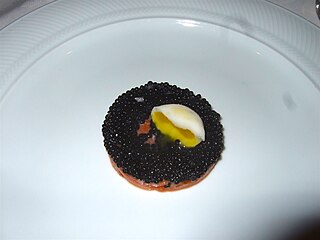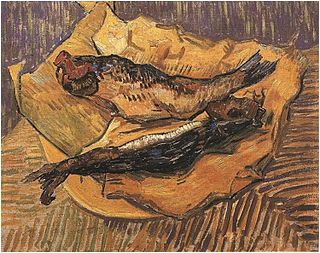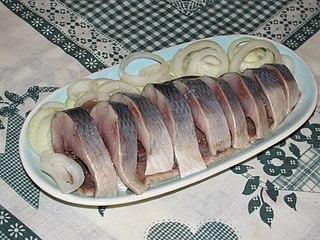 W
WHerring are forage fish in the wild, mostly belonging to the family Clupeidae, but they are also an important food for humans. Herring often move in large schools around fishing banks and near the coast. The most abundant and commercially important species belong to the genus Clupea, found particularly in shallow, temperate waters of the North Pacific and North Atlantic Oceans, including the Baltic Sea, as well as off the west coast of South America. Three species of Clupea are recognized; the main taxon, the Atlantic herring, accounts for over half the world's commercial capture of herrings.
 W
WAvruga is a product made from herring and other products that is marketed as a caviar substitute. Unlike caviar, it does not contain fish roe.
 W
WBloaters are a type of whole cold-smoked herring. Bloaters are "salted and lightly smoked without gutting, giving a characteristic slightly gamey flavour" and are particularly associated with Great Yarmouth, England. Popular in the 19th and early 20th centuries, the food is now described as rare. Bloaters are sometimes called Yarmouth bloater, or, jokingly, as a Yarmouth capon, two-eyed steak, or Billingsgate pheasant.
 W
WBrathering is a simple and traditional German dish of marinated fried herring. It is typical for the cuisine in northern Germany and the northen parts of the Netherlands, either for lunch or as a snack at fast food stands or take-out restaurants.
 W
WA buckling is a form of hot-smoked herring similar to the kipper and the bloater. The head and guts are removed but the roe or milt remain. They may be eaten hot or cold.
 W
WCraster kippers are kippers from the Northumberland village of Craster. They have been acclaimed as the best British kipper.
 W
WDressed herring, colloquially known as herring under a fur coat, is a layered salad composed of diced pickled herring covered with layers of grated boiled vegetables, chopped onions, and mayonnaise. Some variations of this dish include a layer of fresh grated apple while some do not.
 W
WPickled herring is a traditional way of preserving herring as food by pickling or curing.
 W
WRollmops are pickled herring fillets, rolled into a cylindrical shape, often around a savoury filling.
 W
WThe silver-stripe round herring, slender sprat, or Kibinago minnow is a small, herring-like forage fish. They are small fish used as fishing bait, especially in skipjack tuna-fishing. It is valued as food in Japan, where it is known as kibinago. These can be eaten raw, as sashimi, or cooked, as whitebait.
 W
WSolomon Gundy is a Jamaican pickled fish pâté usually served with crackers as an appetizer.
 W
WSoused herring is raw herring soaked in a mild preserving liquid. It can be raw herring in a mild vinegar pickle or Dutch brined herring. As well as vinegar, the marinade might contain cider, wine or tea, sugar, herbs, spices, and chopped onion.
 W
WSpekesild is Atlantic herring preserved using salt.
 W
WSurströmming is a lightly-salted fermented Baltic Sea herring traditional to Swedish cuisine since at least the 16th century.
 W
WVorschmack or forshmak is an originally East European dish made of salty minced fish or meat. Different variants of this dish are especially common in Ashkenazi Jewish and Finnish cuisine. Some varieties are also known in Russian and Polish cuisine.